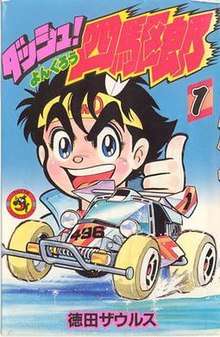Dash! Yonkuro
| Dash! Yonkuro | |
 Cover of the first manga volume | |
| ダッシュ!四駆郎 (Dasshu! Yonkarō) | |
|---|---|
| Genre | Sports (Racing), Action, Science Fiction |
| Manga | |
| Written by | Zaurus Tokuda |
| Published by | Shogakukan |
| Demographic | Shōnen |
| Magazine | CoroCoro Comic |
| Original run | December 1987 – March 1992 |
| Volumes | 14 |
| Anime television series | |
| Directed by | Hitoshi Namba |
| Produced by | Hiroshi Sasagawa |
| Written by | Takashi Yamada |
| Music by | Keita Miyahara |
| Studio | Staff 21, Aubekku & Tokyu Agency |
| Original network | TV Tokyo |
| Original run | October 3, 1989 – March 27, 1990 |
| Episodes | 25 |
| Manga | |
| Hyper Dash! Yonkuro | |
| Written by | Hiroyuki Takei |
| Published by | Shogakukan |
| Demographic | Seinen |
| Magazine | CoroCoro Aniki |
| Original run | March 14, 2015 – present |
| Volumes | 2 |
Dash! Yonkuro (ダッシュ!四駆郎 Dasshu! Yonkurō) is a Japanese manga series created by Zaurus Tokuda, originally serialized in Shogakukan's CoroCoro Comic magazine from December 1987 to March 1992. The story focuses on Yonkuro Hinomaru, a delinquent Mini-4WD enthusiast and member of a Mini 4WD racing team who tackles the world of miniature car racing. It is created as a tie-in to Tamiya's Mini 4WD franchise, and it is the first series to center on the franchise. An anime series based on the original manga was produced by Staff 21, Aubekku & Tokyu Agency and aired on TV Tokyo from October 3, 1989 to March 27, 1990. A sequel manga series, titled Hyper Dash! Yonkuro was created and illustrated by Hiroyuki Takei and began serialization on CoroCoro Aniki in March 14, 2015.
Plot
The story is a succession of races in fancy routes (pyramids, labyrinths, etc.) and tracks fit to make the cars race. During the series run, many characters will appear, like Momotaro (and his Mini 4WD, Crimson Glory, DashWarriors'last obstacle towards the final victory), Sabu Kinjiro (Aero Solitude) and also Jin that will race the Hell Rally with a new Mini4wd, the Proto Emperor ZX (the previous one was the Dash-X1 Proto Emperor, defeated in the regional finals by Yonkuro's then new mini4wd, the Dash-01 Super Emperor). The tracks become always more harder and the stories unlikely (in a volume of the manga, is mentioned that even the prehistoric children used mini4wd-like cars built with natural materials like wood and leaves that would be pushed by the wind), the story always will focus even more on which one would be the true "Emperor", it will be discovered are many mini4wds with this title that will confront against Yonkuro's Emperor, until the epilogue, in the epic challenge of the Hell Rally.
in this race Yonkuro will challenge a group of delinquents that want to take advantage of the best mini4wd racers to manage recovering a treasure hidden during the World War II by the nazis. Between his opponents there will be a revived Ken Hinomaru, ready to challenge the son and test his abilities with his new mini 4wd, the Dash-0 Infinite Boundless. In the end, Yonkuro, helped by his teammates (now far from racing, but always bound by a deep friendship), triumphs with his new car, the Liberty Emperor.
Media
Manga
The manga was written and illustrated by Zaurus Tokuda, serialized in the monthly CoroCoro Comic from December 1987 until March 1992, compiling it into 14 Tankobon volumes. Several spinoff stories revolving the series were released before its successor series was serialized. This, alongside Bakusō Kyōdai Let's & Go!! contributed on the popularity of Tamiya's Mini 4WD franchise in Japan and overseas. Despite the author's death, a sequel manga series, titled Hyper Dash! Yonkuro (ハイパーダッシュ! 四駆郎 Haipā Dasshu! Yonkurō) was created by Hiroyuki Takei (under Tokuda's family approval) and began serialization in CoroCoro Aniki magazine in March 14, 2015. 2 Tankobon Volumes were released so far in Japan.
Anime
An anime adaptation of the original manga was produced by Staff 21, Aubekku & Tokyu Agency and aired on TV Tokyo from October 3, 1989 to March 27, 1990, replacing Mister Ajikko in its original timeslot. The series was directed by Hitoshi Namba and written by Takashi Yamada (Ojamajo Doremi, Jewelpet, HeartCatch PreCure). The opening song is titled "Be Top" by Taku Kitahara while the ending theme is titled "An Endless Challenge" (果てしなき挑戦(チャレンジ) Hateshinaki Charenji) by Taku Kitahara.
Merchendise
Merchandise of the series were released by Tamiya under the Mini 4WD line of race car models.
Reception
Hiroyuki Takei, author of Shaman King and later Hyper Dash! Yonkuro cited he once submitted a design on a contest held by Shogakukan during his middle school years. Despite not be used for Yonkuro's machine, it became the basis for the Dash-3 Shooting Star. The one-shot autobiography manga Dear Zaurus Tokuda was based on Takei's story.
See also
References
External links
- Dash! Yonkuro (anime) at Anime News Network's encyclopedia